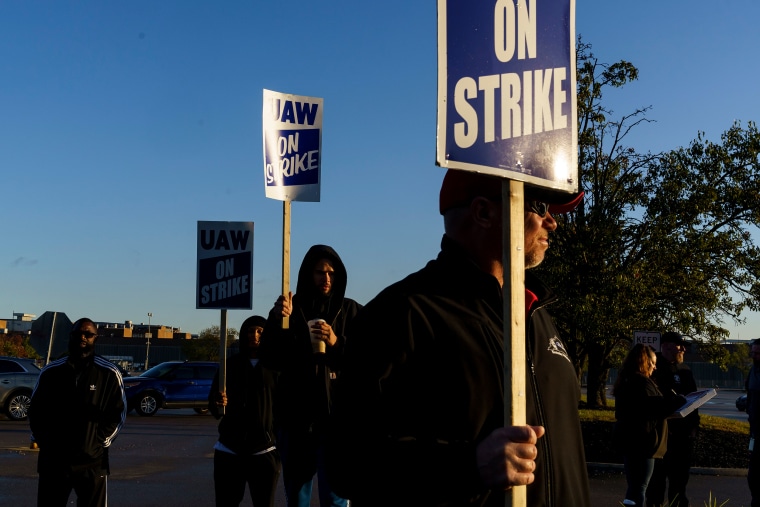The United Auto Workers union says it expanded its strike again Monday, as 6,800 people stopped working at a plant that makes Ram 1500 trucks.
That means this expansion of the strike targets one of Stellantis' most important and profitable vehicles. The union took a similar step with its last walkout, when it shut down a Ford plant in Kentucky where several F-Series Super Duty pickups are made.
The move comes days after UAW President Shawn Fain repeatedly criticized Stellantis, the company that makes Ram, Dodge and Chrysler vehicles. In a Facebook Live broadcast Friday, he said Stellantis "is trying to lowball and undercut us" with contract proposals that were significantly weaker than those offered by Ford and General Motors.

He also said that the company proposed cuts to employees' medical coverage and to 401(k) contributions and that it wanted the right to demand new concessions from workers before the next contract expires.
In a statement Friday, Stellantis said negotiations with the union have been productive without discussing specifics. After Monday's strike, however, the company said it was "outraged" by the union's latest step.
"Last Thursday morning, Stellantis presented a new, improved offer to the UAW, including 23% wage increases over the life of the contract, nearly a 50% increase in our contributions to the retirement savings plan, and additional job security protections for our employees," it said, saying the union had not given it a counteroffer since those latest talks.
The strike at the Sterling Heights Assembly Plant on Monday is the latest step in a labor dispute that has been different from most others in Detroit history. It's the first contract negotiation since Fain, who was sworn into office in March, was elected union president in an upset over incumbent Ray Curry.
Fain is the first UAW president elected directly by members. He'd run on an anti-corruption platform and used more strident anti-corporate rhetoric than his predecessors.
About 40,000 UAW workers at Ford, General Motors and Stellantis are now on strike. They're seeking annual pay raises of more than 40% over a four-year contract, a shorter workweek, improved pensions for retirees, better health care, cost-of-living adjustments and an end to wage tiers.
The automakers have offered record contracts with pay increases of around 20% as well as bonuses and other improved benefits.
The union's strategy
The strike began Sept. 15, when, for the first time, UAW members simultaneously walked off the job at all three companies.
Since then, the union has employed a phased strategy that it calls a "stand up strike," where workers at specific manufacturing plants are told to go on strike with about two hours' notice, making it harder for the automakers to prepare for interruptions in their production and supply lines.
The union has used that approach to play the companies against one another, exempting companies from further strikes when they make more concessions or, as it did Monday, punishing them with new strikes when it says their offers are insufficient.
It also makes it easier for the union to stay on strike for longer. Like many unions, the UAW provides "strike pay" to people who won't earn a paycheck because they've walked off the job. Members get $100 a day in assistance for each day they're on strike. That doesn't make up for all their lost pay.
The union started with more than $800 million in its strike fund, which was enough to provide about 11 weeks of strike pay for all 146,000 members. But more than a month into the strike, it hasn't had to pay out much of that total.
With 40,000 workers on strike, it is expected that the union will be paying about $20 million a week from that fund.
Making an impact
While the automakers' bottom lines have taken a hit, the impact on them has also been smaller than it would have been if more workers walked out.
Last week, Ford Motor Co. Executive Chairman Bill Ford said the strike is a threat to both his company and the U.S. auto industry.
In remarks that illustrated their differing points of view and rhetorical styles, Ford said in a news conference that "this should not be Ford versus the UAW. It should be Ford and the UAW versus Toyota and Honda, Tesla and all the Chinese companies that want to enter our home market."
Later that day, Fain countered that "it's not the UAW and Ford against foreign automakers. It’s autoworkers everywhere against corporate greed."
Close to 5,000 employees at General Motors, Ford and Stellantis, the maker of Chrysler, Dodge and Jeep vehicles, have also been laid off. The automakers have said that's necessary because there is no work for those people to do, while the union has described it as a pressure tactic.
Auto parts suppliers have reported laying off workers as well.
The current strike is now stretching a bit longer than the 2019 strike that hit General Motors, which lasted 31 days before the two sides reached a tentative contract agreement. Some of the UAW's past strikes have lasted several months.
CORRECTION (Oct. 23, 2023, 11:40 a.m. ET): A previous version of this article misspelled the last name of a former UAW president. He is Ray Curry, not Currie.
